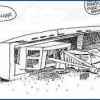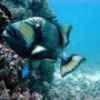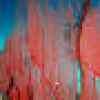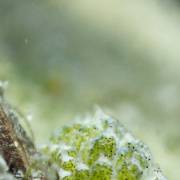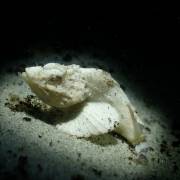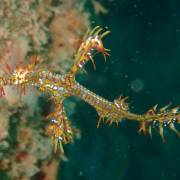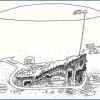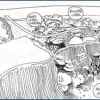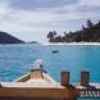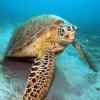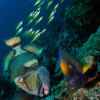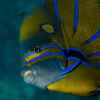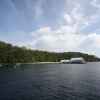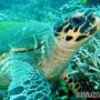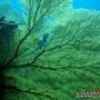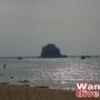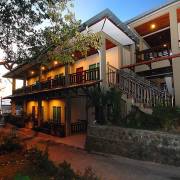Dive in Peninsular Malaysia
-
Sugarship Wreck Perhentian Islands, Malaysia
Sugar Wreck is a sunken freighter located at the west of Pulau Perhentian Kecil and resting 18m below the surface. It sank in 2000 during the monsoon period. As the name suggests, it was previously used for transporting sugar and currently, it is the house for many marine life.Reef adaptation can be… -
Batu Chipor Pulau Redang, Malaysia
Just north of Pulau Ling is a small rocky outcrop that is covered in seafans, gorgonians, whips and sponges. All tropical marine life can be found here (even if there are less fishes that in northern dive sites) . It is barely exposed at low tides and currents can be strong here. -
Big Seamount Pulau Redang, Malaysia
-
Mini Seamount Pulau Redang, Malaysia
-
Pulau Ekor Tebu Pulau Redang, Malaysia
There is an exquisite array of hard corals at this site, all jostling for that optimum light capturing position on the reef. There are blue corals, soft leather corals and some large clams to be found here. The northeast tip of the island comprises mainly of large boulders dropping down to 24 meters… -
Pulau Lima Pulau Redang, Malaysia
A research study in 1976 found Pulau Lima and its associated sea mounts as perhaps the most valuable entity within the Redang marine park as the reefs around this islet represented all environments found elsewhere in Redang, thereby providing a miniaturized view of the entire park's marine… -
Pulau Ling Pulau Redang, Malaysia
This small island is best known for two massive coral heads which are said to be the largest off the Malay Peninsular. The larger of the mammouth Porites measures around 25 meters across at its base circumference. They are both over a hundred years old and the small caves around the bottom attract… -
Pulau Paku Besar South Pulau Redang, Malaysia
A stone's throw away are the islands of Pulau Paku Besar and Pulau Paku Kecil which are popular snorkelling haunts but also have enough to keep divers happy. -
Tanjung Gua Kawah Pulau Redang, Malaysia
At the northeastern tip of Redang, Tanjung Gua Kawah tends to have strong surface and deep-water currents and is best left to experienced divers. Rocks and boulders descend to sandy bottom at around 15 metres. Coral growth is average but due to the currents, there are opportunities to encounter… -
Teluk Dalam Pulau Redang, Malaysia
Nice bay, great for snorkelers. Turtles can be found here near the coral garden area. -
Terumbu Kili Pulau Redang, Malaysia
Terumbu Kili, a rocky outcrop that appears above water and slopes down to a sandy bottom at about 20 metres in depth, lies at the southern tip of Pulau Pinang and is one of the top dive sites at Redang.Beware the strong surface currents in the channel separating this outcrop from Pulau Pinang. Due… -
Turtle Bay Pulau Redang, Malaysia
The bay is very calm and the main interest is turtles. This site is good for snorkeling. -
Tanjung Tokong Pulau Redang, Malaysia
In the noth side of the island, situated just around from Turtle Bay this spot is well renowned for seeing Green and Hawksbill turtles. In addition to the turtles there are many varieties of reef fish here around the submerged boulders. Currents can be stronger and these often bring in the bigger… -
Tunnel Point Pulau Redang, Malaysia
A little further south from tanjung Tokong, there is an array of boulders that create caves, swinthroughs and canyons. Close inspections is rewarded by sights of the shyer marine inhabitants lurking in the darkness. -
Mak Cantik Pulau Redang, Malaysia
Close to Chek Isa is Mak Cantik (which means 'beautiful mother' in Malay), an underwater seamount in waters 12-18 metres deep that's home to a large coral garden comprising many hard and soft corals. Some divers prefer this to Chek Isa as the coral gardens here are prettier, including some lovely… -
Chek Isa Pulau Redang, Malaysia
The submerged reef here is bouyed and starts at 8 meters deep where two huge boulders carpeted in soft corals and anemones form a small canyon. Many cracks conceal smaller critters as well as sponges, worms, squirts and stinging hydriods. Cowries, spider shells and colourful Christmas tree worms are… -
Pulau Kerengga Pulau Redang, Malaysia
Northwest of China Terjun are the islands of Pulau Kerengga Besar and Pulau Kerengga Kecil with a large expanse of shallow reef which is ideal for snorkellers as well as novice divers. If Cina Terjun is 'eel & lionfish city', Kerengga is 'ray city' as the shallow sandy bottom around it is home to a… -
Marine Headquarters Wreck Pulau Redang, Malaysia
There is an old wreck of a cargo vessel near the Marine Headquarters on the north of Pulau Pinang. It is now covered in coral and is home to many fish including a stonefish that takes some searching out! -
Batu Tokong Kamudi Pulau Tenggol, Malaysia
-
Coral Garden Pulau Tenggol, Malaysia
The sandy bottom of the sea seems to have sprouted a garden of plenty with large Christmas Tree Worms peeping out of their cubby holes in the coral rock, brightly coloured Nudibranchs sliding over coral, like garden slugs.There are large brain corals scattered around the area, playing host to motley… -
Gua Rajawali Pulau Tenggol, Malaysia
Lots of suspended sediments made us work a little harder when the visibility dropped to about 5m at any time. This site is similar to the coral garden and is thickly blanketed with soft and hard corals alike and plenty of starfishes and even tennis sponges lay at the bottom and in between rocks. A… -
Pulau Nyireh Pulau Tenggol, Malaysia
Great dive site for novice and snorkelers. Schools of barracuda and tuna, groupers, rays, and all the tropical marine life. -
Rajawali reef Pulau Tenggol, Malaysia
This is a very popular dive site both interesting for dive training and snorkeling (near the beach). Sharks and mantas can be seen here during exercices ! -
Tanjung Pasir Pulau Tenggol, Malaysia
This is the best dive we've done in Pulau Tenggol. Reef is good, but the best is shoals of Barracudas, Jacks and Tunas. A great drift dive, maybe not for beginers cos of the strong currents. -
Teluk Air Tawar Pulau Tenggol, Malaysia
-
Tokong Timor/ White Rock Pulau Tenggol, Malaysia
This site is approximately 300m off the south western side of the main island. The terrain is generally flat but littered with rocks and boulders. Feather stars of a variety of colours (even white ones) cling on to the surfaces of barrel sponges and anywhere that has good current flow. Sea grass… -
Turtle Point Pulau Tenggol, Malaysia
-
Tanjung Cina Terjun Pulau Tenggol, Malaysia
If there is one place in Redang that qualifies as a macro photographer's wonderland, it must be Cina Terjun, one of my favourite sites in Redang. It might as well be called 'eel & lionfish city' too since divers are almost certain to encounter eels and lionfish here.The sandy bottom fringing the… -
Amazing Grace Pulau Tenggol, Malaysia
Drift dive with amazing wall coral and big fishes.2 Large White Tip shark around the corner. Size up to 2 - 3 metre. -
The Highway Pulau Lang Tengah, Malaysia
Many experienced divers cherish this spot for its swift currents - the feel of the rush. This dive should only be attempted by divers with wide diving experience in open sea conditions.The strong eddy currents on the surface may be a little unsettling but the undercurrent tops it all. Follow your… -
Pulau Pinang Pulau Aur, Malaysia
Pulau Pinang off the southern coast has a rocky wall that drops down to around 50 meters. -
3 Pinnacles Pulau Aur, Malaysia
Off the southern coast of Aur are three pinnacles that rise from 30 meters to just below the surface, they are covered in untouched table corals. Schools of batfish, jacks and trevally are common here but currents can be strong -
Rayner's Rock Pulau Aur, Malaysia
Rayner's Rock off the northeast coast of Dayang Island has rock and boulder formations dropping to 30 meters, with big humphead wrasse and barracuda present here, it is one of the local favourite spots. Also the best place in the area for that manta or whale shark sighting. -
Captain Point Pulau Aur, Malaysia
Off the northern point of Dayang is Captain Point where drift diving along the soft coral walls is popular, again keeping a lookout for manta and eagle rays. -
Chebeh Island Pulau Tioman, Malaysia
There are a number of spots around Chebeh Island, the most popular being the northeast and southeast corners. The large volcanic rocks form canyons and swimthroughs often full of schooling yellowtail fusiliers, there is also a large cavern filled with glassfish around the 20 meter mark on the… -
Sepoi Island Pulau Tioman, Malaysia
Sepoi is one of the further islands from Tioman, hence it is not dived as frequently as the others. Often done as a drift dive around the island up and over the volcanic boulders.Golden Reef Just off the northeastern edge of Sepoi Island is a submerged reef where sea fans, soft corals and sponges… -
Marine Park Wrecks Pulau Tioman, Malaysia
In the south of Soyak island, there are 8 wrecks located off the beach at the Marine Park headquaters. They are all connected so navigation is relatively simple and inquisitive batfish will often follow you around. Big shoals of fusiliers, jacks and trevallys can be seen around the wrecks.Pirate… -
Renggis Island Pulau Tioman, Malaysia
Renggis Island is one of Tioman's top dive spots, hence it can get busy at times. Sub surface on the eastern side of the island is a reef teeming with life with all manner of corals, sponges and anemones and a multitude of fish. This site is often used for training and night dives, it is also one of… -
Tiger Reef Salang, Malaysia
This submerged reef lies in the channel between the islands of Sepoi and Labas. Some impressive coral formations can be seen here such as plate, brain and fire coral. It is one of the most impressive reefs in the area, covered in hard and soft coral it attracts thousands of fish including snapper,… -
Salang Jetty / House Reef Salang, Malaysia
Salang Bay has two easily accessible house reefs with a reasonable depth range of 5 to 15 meters. Two perfect locations to update your skills after a long period of inactivity. After you have practiced your skills in the sandy area you can explore the reef either side of the jetty.Not only divers… -
Labas Island Salang, Malaysia
This island resembles a piece of Swiss Cheese due to its abundance of caverns. Labas Island has two dive sites to offer the head or the tail, with both being equally challenging and simply fascinating. Whether you are swimming through the labyrinth of swim troughs or gliding along the dense coral… -
KM Sipadan / Sawadee Wrecks ABC, Malaysia
KM Sipadan was a former Malaysian Navy Warship that was sunk to become an artificial reef in March 2012.It's attracted lots of fishlife and thanks to the large openings can be penetrated from stern to bow or vice versa.The wreck sits upright at 30m depth and is connected with lines to 2 former… -
Amigo House Reef, Juara,… Juara, Malaysia
Right in front of Amigo Dive Center Juara Tioman -
Juara House Reef, Juara,… Juara, Malaysia
Walking distance from Amigo Dive Center Juara Tioman -
Karang Tohor, Juara, Tioman Juara, Malaysia
Only 5 minutes away from Amigo Dive Center Juara Tioman -
Batu Nisan Perhentian Islands, Malaysia
A gentler and shallower dive here where there is an abundance of giant clams, anemones and christmas tree worms. There maybe stingrays resting on the sandy bottom here. A good spot for a night dive as crabs, shrips and feather stars are in abundance as are parrotfish which will be asleep and encased… -
Seahorse Drift Perhentian Islands, Malaysia
Seahorse drift is the best place in the perhentian for muck diving. Really close to the small island, but only accesible by boat. Is in the chanell between the two islands, so the current is always strong, therefore is perfect for drift diving. The best moment for this dive is at sunrise where… -
Pasir Kerangi Perhentian Islands, Malaysia
Artificial Reef made of PVC pipes anchored on sand in 1991. -
Pasir Tani Wreck / Vietnamese Perhentian Islands, Malaysia
One of the more popular diving sites, known as the Vietnamese Shipwreck, it's is located at the southwestern side of Pulau Perhentian Kecil.Actually it is an American landing craft which sank in 1976. Nowadays divers can find half of a steel landing craft while the location of the other half of the… -
Pulau Rawa Perhentian Islands, Malaysia
Another series of underwater boulders just off the tip of the smaller outer islands. There are a couple of small caves and swimthroughs here and some nice black coral and sea fans. Nurse sharks may be spotted resting in the crevices here. -
Pulau Susu Dara Besar Perhentian Islands, Malaysia
Marine life is similar to Tokong Laut, with less coral life. -
Shark Point/ Light House Perhentian Islands, Malaysia
Vast extension of hard coral,and the usual reef life. Easy to spot black tip sharks (when visibility is good) and home of turtles, needle fish, puffers, some barracuda, etc. In 2010 one diving school sunk an old piano there. It's locations shouldn't be difficult: In the Flora Bay side of this site… -
Terumbu Tiga / Three Rocks Perhentian Islands, Malaysia
Terumbu Tiga lies to the east of the bigger of the two Perhentian Islands (Besar) and is accessed by boat. Its a collection of rocks, which provide a great habitat for critters, with very clear water and fun swim-throughs. This formation of large boulders is potentially the most picturesque site in… -
Tokong Laut / Temple of the… Perhentian Islands, Malaysia
Massive pinnacle, sand at the bottom. Probably the best site in the Perhentians, with great marinelife diversity: scorpionfish, schools of yellow snappers, boxfish, pufferfish, bamboo sharks, nurse sharks, some occasional black tip shark, a house turtle, nudis and schools of reef fish. -
D'Lagoon Perhentian Islands, Malaysia
Surrounding a small sandy lagoon is a lively bed of colourful hard corals. This chilled out dive will find you face-to-face with a wide variety of reef life, ranging from the magnificent school of giant bumphead parrotfish to the adorable Clownfish. You can even stop in for a manicure provided by… -
Tanjung Basi Perhentian Islands, Malaysia
With fantastic hard coral beds and massive rock boulders to explore, this is a relaxing dive which offers a wide range of coral and fish life. Soft corals, including fans and whips are in abundance, also offering good chances of spotting sea turtle and giant moray eel. Three species of triggerfish… -
Batu Layar/ Sail Rock Perhentian Islands, Malaysia
With a huge staghorn coral field in prefect condition and massive table corals, this site has some of the best hard corals anywhere in the Perhentian's. A resident school of Fosters barracuda surround you on the descent and within the rocks a variety of moray and crab can be seen. Sea turtle are… -
House Reef Perhentian Islands, Malaysia
Western Bay of Teluk Air Tawar (Fresh Water Bay).‘House Reef’ means just that! Suit up on the beach and just wade into the warm bay water. The seabed slopes gently from the shoreline. Approximately 50m(at lowtide) from the shore the floor drops away. This sheer drop spreads across the bay and… -
Secret reef / Hidden reef Perhentian Islands, Malaysia
This is a dive site that not many dive centers do, for various reasons: it's farther out and exposed to the sea, it's deep (so it's only recommended for Advanced people), and it's hidden.. But once you find it, it's worth the trouble! It has an interesting coral reef at around 30m deep and it's the… -
Coral Garden Langkawi, Malaysia
The southwestern tip of Pulau Payar offers a panoramic coral garden with steep canyons and crevices dropping down to around 18 meters. Marine life includes titan triggers, morays, lionfish and pufferfish. A litter further south is "Grouper Farm" named after the large number of resident groupers,… -
House reef Langkawi, Malaysia
The most visited site at Pulau Payar is the House Reef. A sandy bay that houses the entire facility of the Marine Park center is in fact the center of attraction for most tourist visiting this island. A fringing reef consist of scattered coral heads is located just fifty meters from shore. -
Kaca sunken wrecks Langkawi, Malaysia
South of the island is an artificial reef made up of seven sunken confiscated fishing boats. The wrecks are home to a wide variety of fishlife including jacks, mangrove snappers and groupers. Also mollusks and nudibranchs can be found among the scattered vessels. Navigation is relatively simple and… -
Pulau Segantang Langkawi, Malaysia
This small island lies 13 kilometers west of Pulau Payar, it features steep rocky terrain down to 20 meters. Fish life is in abundance with barracuda, jacks, snappers and often nurse sharks. Tyre Reef is the most popular site here, there is also an anemone garden round the northern side of… -
Platform Langkawi, Malaysia
-
Platform Reef Langkawi, Malaysia
Pulau Payar Marine Park, 59km north of Penang and 35km south of Langkawi is truly a nature paradise which embraces lush forestation, white sandy beaches and superb coral gardens that is home to a vast diversity of magnificent corals and colorful marine life. Gorgeous coral garden in the marine park… -
White coral corner Langkawi, Malaysia
Amazing soft corals; fans, whips, harps. Anemones with clownfish. Chance to see: seahorses, pipefish, nudis, crabs, shrimps, snapper, fuseliers, barracuda, porcupines, puffers, bambooshark -
Barracuda island Langkawi, Malaysia
Diving at different sides of this island could show you barracudas or trevallies. Seahorses, frogfish, nudies, crabs, shrimps, pipefish and lots of anemonefish. We even spot the blue ringed angelfish here sometimes. -
Diamond point Langkawi, Malaysia
A slow drift pushes you over the fields of whipcorals where you look for flatheads, seahorses, frogfish, clownfish, puffers, filefish or shrimps. -
The Stables Langkawi, Malaysia
Going really slow and close to the muddy bottom, look for pipefish, seahorses and nudis. If you like the small creatures this is an amazing divesite. -
Captain point Johor, Malaysia
Classical drift dive with Mantas and eagle rays. -
Pinnacle II Johor, Malaysia
Cleaning station for Bat fishes, you'll encounter a lot of them -
Pulau Babi Tengah Johor, Malaysia
This dive site is into the marine park, and you can find some leatherback turtles in july! -
Pulau Pemanggil Johor, Malaysia
On the east side of Pulau Pemanggil is an old unknown shipwreck. The wreck is covered of fish. Very nice dive. -
Pulau Pinang Johor, Malaysia
-
Pulau Rawa Johor, Malaysia
Good Beaches and snorkelling, healthy ìSTAG'S-HORN CORALî surrounding both beaches with easy access for snorkelling. New dive centre opening Feb / March 2010 -
Rayner's rock Johor, Malaysia
A lot of different sharks may be seen here: Whitetip sharks, Hammerheads sharks, Whale sharks, as well as Mantas -
Bahara Rocks Pahang, Malaysia
-
Magicienne Rock Pahang, Malaysia
This pinnacle raises up to 8 m. This is one of the best dive of the Pahang marine park: Whale Shark, Leopard Shark, Mantas can be seen here! -
Pulau Chebeh Pahang, Malaysia
-
Pulau Chebeh SouthEast Pahang, Malaysia
Great white gorgonians and sea fans. Also seen : Stingrays, Napoleon wrasse, two turtles and a goatfish. -
Pulau Labas Pahang, Malaysia
Reef fish shoals among volcanic rocks.Note: The small skeleton wreck on the northwest side is not really interesting. -
Pulau Renggis Pahang, Malaysia
-
Pulau Tulai Pahang, Malaysia
-
Soyak Pahang, Malaysia
-
Teluk Kador Pahang, Malaysia
-
Tiger Rocks Pahang, Malaysia
Jacks, barracudas, stingrays, turtles, and sometime sharks (including whale shark). -
Tioman Pahang, Malaysia
-
Fan Canyon Pahang, Malaysia
Fan Canyon is located on famous Coral Island and named after the Gorgonia Sea Fans which grow between two large granite boulders.It's a sloping reef with easy access formed of granite boulders which are densely covered in a variety of soft corals at depeer depths and hard corals in the shallows.
